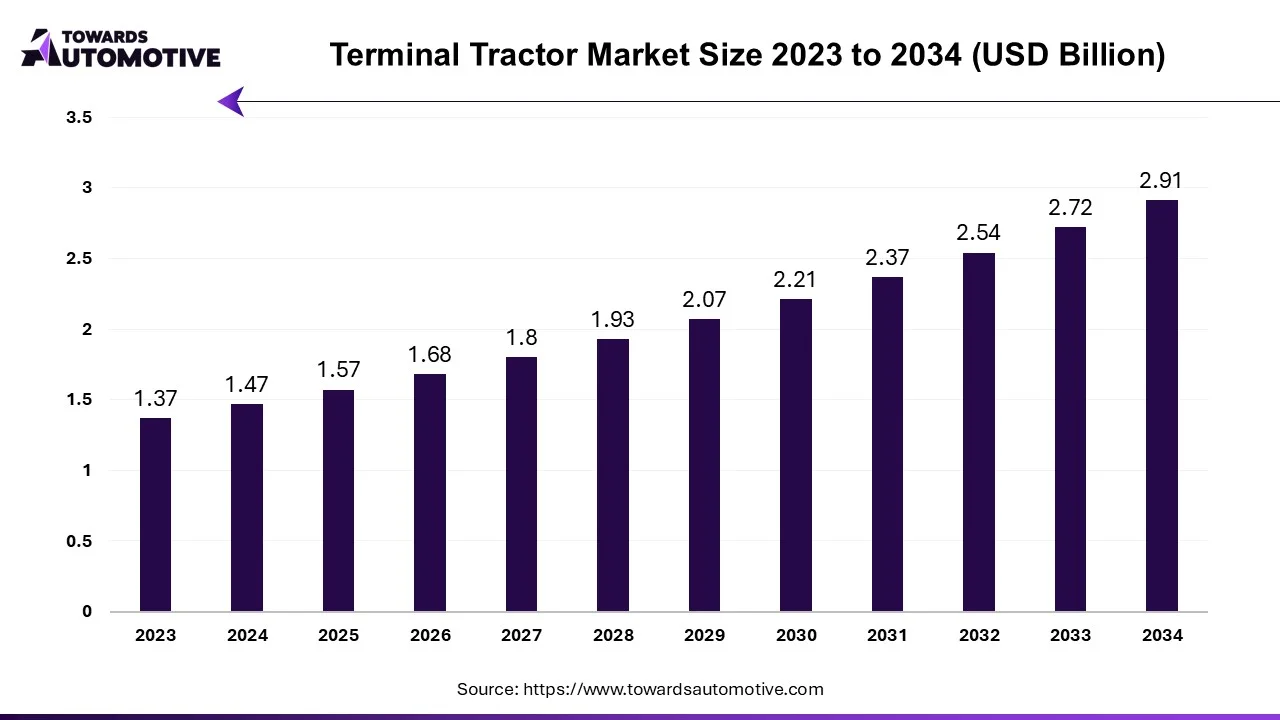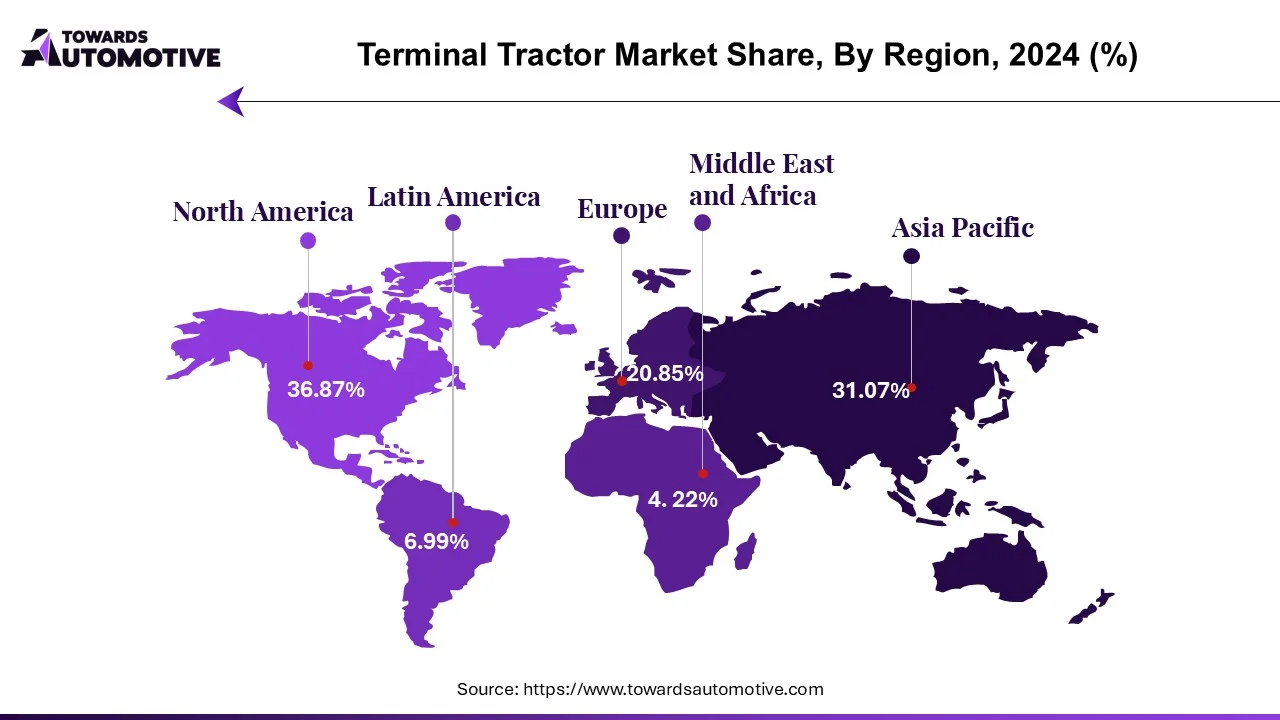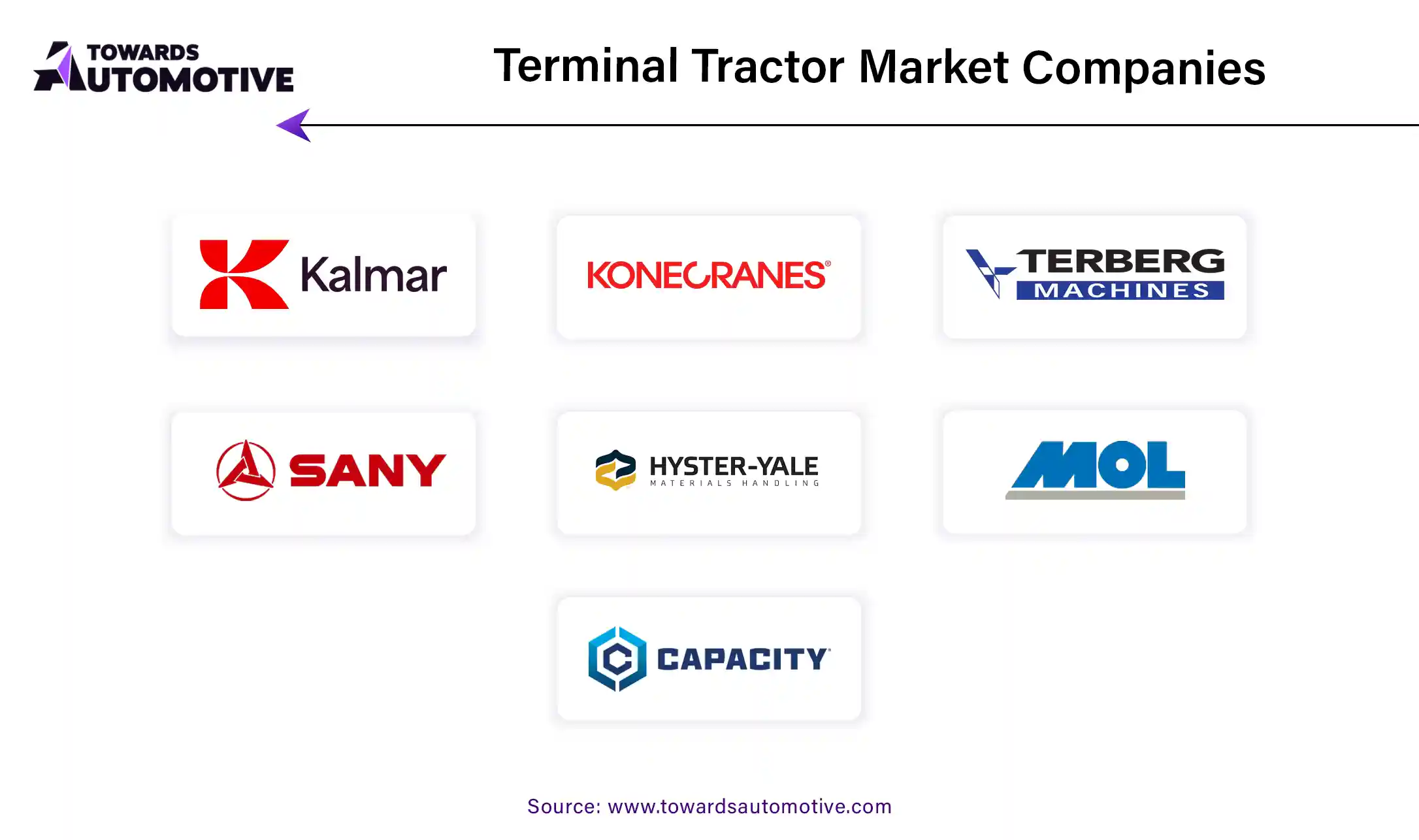April 2025
The terminal tractor market size is calculated at USD 1.47 billion in 2024 and is anticipated to reach around USD 2.91 billion by 2034, growing at a CAGR of 7.09% from 2025 to 2034.

Unlock Infinite Advantages: Subscribe to Annual Membership
The terminal tractor market has seen substantial growth in recent years, fueled by the increasing demand for efficient, specialized vehicles used in logistics and freight operations. Terminal tractors, also known as yard trucks, hostlers, or shunt trucks, play a vital role in ports, distribution centers, rail yards, and warehouses, where they are used to move containers and trailers within confined spaces. These vehicles help streamline the transfer of goods, reduce congestion, and increase the speed of cargo handling, essential in today's fast-paced global trade environment.
The growth of e-commerce, expansion of port infrastructure, and the rising need for automated, fuel-efficient, and eco-friendly solutions have further boosted the demand for terminal tractors. Technological advancements such as electric and hybrid terminal tractors, along with automation systems, are contributing to reducing operational costs and enhancing sustainability in the industry. In addition, emerging economies, particularly in Asia-Pacific and Latin America, are investing in modernizing their logistics and transportation infrastructure, which drives the demand for these vehicles.
Artificial intelligence (AI) is playing a transformative role in the terminal tractor market by enhancing efficiency, safety, and automation in logistics and cargo handling operations. AI technologies are being integrated into terminal tractors to optimize their performance and enable more streamlined operations at ports, distribution centers, and rail yards.
AI enables autonomous terminal tractors to navigate and perform tasks without human intervention. By utilizing AI-powered systems, terminal tractors can move containers and trailers more accurately and safely, reducing the need for manual labor. AI algorithms process data from sensors, cameras, and GPS systems to allow the vehicles to navigate complex environments, avoid obstacles, and follow predetermined routes with minimal human oversight.
AI can improve fleet management by using predictive analytics to monitor vehicle performance, track maintenance schedules, and anticipate potential failures before they occur. This reduces downtime, increases the lifespan of terminal tractors, and ensures smooth operations. AI-driven software can also help optimize the allocation of terminal tractors, directing them to the areas of highest need based on real-time data.
AI-powered systems help improve safety by using machine learning and computer vision to detect obstacles and hazards in the vehicle's path. By recognizing potential dangers in real-time, these systems can take corrective actions, such as slowing down or changing course, to avoid accidents and prevent damage to goods and equipment.
The rapid growth of the e-commerce sector is a key driver of the terminal tractor market, as it significantly impacts the demand for efficient logistics and distribution systems. As e-commerce continues to expand globally, the volume of goods being shipped and delivered has increased dramatically, requiring highly efficient supply chain operations. This surge in demand for fast and reliable deliveries places considerable pressure on distribution centers, warehouses, and port terminals to handle large volumes of goods quickly and accurately. Terminal tractors, which are essential for moving containers, trailers, and goods within these facilities, play a critical role in maintaining smooth operations.
The need for quick turnaround times and the optimization of space in increasingly congested distribution hubs drives the adoption of terminal tractors, which allow for more efficient movement of goods across short distances. E-commerce companies are also looking to streamline their operations, reduce costs, and improve the speed of their logistics, further increasing the need for advanced terminal tractors equipped with features such as automation and telematics. Additionally, as e-commerce businesses expand globally, they are increasingly relying on intermodal transportation to move goods across various transportation modes (e.g., road, rail, and sea), which creates additional demand for terminal tractors at intermodal terminals. As the e-commerce sector continues to evolve and expand, the terminal tractor market will benefit from the ongoing need for innovative and efficient cargo handling solutions to support these rapidly growing logistics networks.
The terminal tractor market faces several restraints, including high initial investment costs and ongoing maintenance expenses, which can be a barrier for small and medium-sized enterprises. Additionally, the complexity of managing large fleets, coupled with the need for specialized operators, poses operational challenges. Furthermore, the limited availability of skilled labor for advanced automated systems and stringent regulatory requirements related to emissions and safety standards can hinder market growth. These factors may slow the adoption of terminal tractors, particularly in developing regions.
The rapid adoption of advanced telematics solutions is creating significant opportunities in the terminal tractor market by enhancing fleet management, operational efficiency, and overall productivity. Telematics, which involves the integration of GPS, sensors, and real-time data analytics, allows operators to monitor the performance of terminal tractors remotely, providing insights into fuel consumption, engine health, maintenance schedules, and driver behavior. This data-driven approach enables logistics companies to optimize their fleet operations, reduce downtime, and extend the lifespan of terminal tractors. Additionally, telematics solutions improve route planning and reduce idle times, resulting in cost savings and better resource allocation within port terminals and distribution centers.
The ability to track terminal tractors in real-time also increases security and reduces the risk of theft or unauthorized usage. Furthermore, telematics solutions play a crucial role in predictive maintenance, alerting fleet managers to potential issues before they lead to breakdowns, thereby minimizing costly repairs and operational disruptions. As automation and digitalization become increasingly prominent in logistics, the demand for telematics-equipped terminal tractors is growing. The integration of telematics with advanced technologies such as AI and automation offers even more opportunities to further enhance productivity, safety, and sustainability. Consequently, the growing adoption of telematics is driving innovation in the terminal tractor market, offering operators greater control and efficiency, while meeting the demands of an evolving and competitive logistics industry.
The port terminal segment held a dominant share of the market. The port terminal segment plays a pivotal role in driving the growth of the terminal tractor market, as these vehicles are essential for the efficient movement of containers and trailers within port facilities. Ports are the primary gateways for global trade, handling vast amounts of cargo every day, and the smooth operation of these ports heavily relies on specialized equipment like terminal tractors. These vehicles are designed to transport containers short distances within the port, shuttling them between vessels, trucks, railcars, and storage yards. As global trade continues to expand and ports grow in size and complexity, the demand for terminal tractors to manage increased cargo volumes has surged. In particular, the expansion of port infrastructure and the need for faster, more efficient logistics operations are driving the adoption of advanced terminal tractors. These include electric and autonomous models, which reduce operational costs, improve energy efficiency, and help meet increasingly strict environmental regulations.
Additionally, the ongoing modernization of port facilities, particularly in emerging markets, is creating further demand for state-of-the-art terminal trucks that can handle the sophisticated needs of large-scale cargo handling. With the increasing trend toward automation in ports, terminal tractors integrated with smart technologies such as AI and GPS are becoming more common, enabling enhanced operational efficiency, safety, and fleet management. Thus, the port terminal segment remains a key driver of growth for the terminal tractor market, with ongoing investments in port infrastructure and technology shaping the future of logistics and cargo movement worldwide.
The manual segment led the industry. The manual segment continues to play a significant role in driving the growth of the terminal tractor market, particularly in regions and industries where cost-effective, straightforward, and flexible solutions are needed for cargo handling. Manual terminal tractors are widely used in port terminals, distribution centers, and rail yards where their simplicity and reliability make them an ideal choice for short-distance trailer and container movements. Despite the growing interest in automated and electric terminal tractors, manual models remain essential due to their lower upfront costs, ease of operation, and ability to handle a wide variety of tasks without requiring advanced technical infrastructure.
In emerging markets and smaller facilities, where budget constraints may limit the adoption of automated systems, manual terminal tractors offer a practical solution. Additionally, the manual segment is driven by the demand for versatile, customizable vehicles that can be operated by human drivers, offering greater flexibility in handling diverse cargo types and terminal configurations. The ongoing need for manual terminal tractors is particularly evident in regions where labor costs are lower, and operational agility is critical. Furthermore, the manual segment complements the growing trend of mixed fleets, where both manual and automated terminal tractors coexist in large logistics operations, helping businesses gradually transition toward more advanced systems. Thus, the manual segment remains a crucial component of the terminal tractor market, offering a cost-effective and adaptable solution that meets the diverse needs of global logistics and cargo handling operations.

North America dominated the terminal tractor market. In North America, robust trade and logistics infrastructure, coupled with the rapid growth of e-commerce and the increasing demand for intermodal transportation, are significant factors driving the growth of the terminal tractor market. North America is home to some of the world’s busiest and most advanced ports, such as those in the United States and Canada, where ongoing investments in port expansion and modernization are essential to keeping up with the growing demand for goods. As these ports handle higher cargo volumes, terminal tractors are required to ensure the efficient movement of containers and trailers within terminals.
Additionally, the rapid growth of e-commerce, particularly in the U.S. and Canada, has led to an increased need for fast, reliable, and efficient logistics networks. This has fueled the demand for terminal tractors, which facilitate the quick transfer of goods between warehouses, distribution centers, and ports. The rising trend of intermodal transportation, where goods are transported using a combination of rail, road, and sea freight, is further driving the need for terminal tractors. These vehicles are crucial for transferring containers between different modes of transport at intermodal terminals, enhancing the efficiency of supply chains. As logistics companies and port operators seek to streamline operations, reduce costs, and meet the growing demand for goods, the terminal tractor market in North America is experiencing strong growth, supported by advancements in infrastructure, automation, and intermodal logistics solutions.
Asia Pacific is expected to grow with the highest CAGR during the forecast period. The rapid expansion of port infrastructure and overall infrastructure development in the Asia-Pacific (APAC) region is a key driver of growth for the terminal tractor market. As APAC continues to emerge as a global trade hub, the region’s ports are expanding to accommodate higher trade volumes and larger ships. This growth in port infrastructure necessitates the adoption of efficient cargo handling solutions, with terminal tractors playing a vital role in moving containers and trailers within port terminals and distribution centers. In particular, countries like China, India, Japan, and Singapore are investing heavily in upgrading their port facilities, creating a direct demand for modern terminal tractors capable of handling increased cargo volumes. Additionally, infrastructure development in emerging economies, such as Vietnam, Indonesia, and the Philippines, is further fueling the demand for terminal tractors.
As these nations enhance their transportation and logistics networks, the need for efficient and advanced equipment, including terminal tractors, increases to support the growing trade and industrial activities. The integration of smart technologies, automation, and sustainability initiatives into these infrastructure projects is also driving demand for more innovative terminal tractors, such as electric and autonomous vehicles. Furthermore, government policies and investments aimed at improving logistics efficiency in the region ensure a continued focus on infrastructure development, creating long-term growth opportunities for the terminal tractor market. As APAC's infrastructure continues to evolve, the demand for terminal tractors will remain strong, making them an essential part of the region's logistics and transportation systems.

By Drive Type
By Application
By Tonnage
By Vehicle Type
By Region
April 2025
April 2025
April 2025
April 2025
We offer automotive expertise for market projections and customizable research, adaptable to diverse strategic approaches.
Contact Us